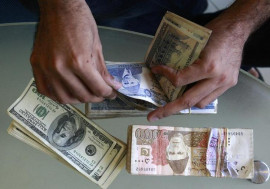
ISLAMABAD: Financial crises during the last two decades have shattered confidence in global currencies. Notable examples include Mexican peso during Tequila crisis of 1994, Thailand Baht and Malaysian ringgit in the 1997 Asian financial crisis, the United States dollar in global financial crisis of late-2008 and most recently Euro during Greek sovereign debt crisis. All of these currencies lost value in double digits at the peak of their respective financial crisis. As is often the case, crisis begets opportunity.
A crypto currency by the name of Bitcoin was launched in 2009 by an unknown person using the alias Satoshi Nakamoto. Being a decentralised currency, Bitcoin transactions do not involve any financial intermediary like banks and no central authority like State Bank of Pakistan (SBP) has any sway over it. Since its launch, Bitcoin has received a lot of attention. The value of one Bitcoin has soared to $2,679.70, which is equivalent to Rs280,939. Public policy makers in advanced economies are contemplating on how to integrate Bitcoin within the ambit of their monetary policies.
However, developing countries like Pakistan where rupee is so prone to volatility due to shaky confidence; the concept of Bitcoin has valuable utility for policy makers. In framing monetary policy particularly, some of the characteristics of Bitcoin are worth mimicking. These characteristics can augment monetary policy of Pakistan in achieving its objectives of ensuring stability of the value of rupee and fuller utilisation of the country’s productive resources.
Stability of rupee
Too much of anything undermines the value. Supply of money determines the true value of a currency in the long run. The practice of printing more rupees in Pakistan is not uncommon. Successive governments in Pakistan have resorted to this practice in a bid to plug financing gaps. In some instances, conventional bend towards expanding money supply as a tool to promote economic activity has also contributed to an ever increasing supply of money. Since 2010, the SBP has issued fresh rupee notes at an average annual rate of 16.5% while the average annual rate of real GDP growth has been just 3.8%. The ensuing rupee glut in the market bears adverse effect on the value of rupee as evident from the recurring bouts of inflation.
Operational protocols of Bitcoin have a built-in mechanism that allows Bitcoins to be created at a fixed rate. First, unlike rupee, which can be issued infinitely, there is finite limit to the amount of Bitcoins that can be available in the Bitcoin system. And that limit is 21 million. Second, Bitcoins are created (mined in technical jargon) by a reward system. A miner is rewarded Bitcoins when she verifies a transaction by solving a mathematical problem. As more Bitcoins are mined, the mathematical riddle becomes harder to crack and hence Bitcoins are being mined at a diminishing rate. It is rule-based system of monetary expansion.
Monetary expansion in Pakistan should be rule-based as well. Monetary base which comprises of rupee notes and coins should be fixed and only the currency in circulation should be adjusted as per circumstances through standard monetary policy tools. Rule-based monetary policy can also be attractive to foreign investors who prefer to invest in a stable rupee run under a consistent and fully anticipated monetary policy rather than an erratic one.
Economic growth
As an internet currency, crypto currencies like Bitcoin are the swiftest medium of transaction. Currently in Pakistan, payment settlement takes quite some time. Bitcoin, on the other hand, settles a transaction in an instant
On top of that, a digital currency can also enhance the market size available to Pakistani businesses. For example, a person living in rural Bhakkar district of Punjab can’t make a purchase from a retailer based in Islamabad unless she has a credit/debit card. For credit/debit card she must have a bank account.
According to Global Findex Report 2014, which is issued by the World Bank, only 13% of adult Pakistani population has a bank account. Based on this, it won’t be hard to digest that only 1% of adult Pakistani population uses some sort of digital currency for transaction. Bitcoin is already fixing such issues. It is giving opportunities to unbanked Africans to shop around the world and as a result it has expanded market for businesses. Some of the businesses are also accepting payments in Bitcoins. Overstocks.com, which is an online retailer, accepts payments in Bitcoins and sells items of every kind ranging from home décor, jewelry, garments to furniture.
Similarly, if rupee is digitised in a way that will require just an internet connection and a Smartphone and no credit/debit card, Pakistani businesses too can observe surge in orders. One way to digitise rupee is by allowing mobile phone users to make payments to sellers of goods and services through mobile balances.
This is already being exercised in Kenya through Vodafone’s Mobile Pesa service. The service even allows users to pay for train and air tickets. Such a service can succeed in Pakistan too because the percentage of population with access to internet and mobile phone is more that the banked population.
As global economies respond to challenges of crypto currencies like Bitcoin, Pakistan should also digitise its monetary policy to promote economic growth.
The writer is Research Associate at the Policy Research Institute of Market Economy
Published in The Express Tribune, June 26th, 2017.
Like Business on Facebook, follow @TribuneBiz on Twitter to stay informed and join in the conversation.




























































COMMENTS (2)
Comments are moderated and generally will be posted if they are on-topic and not abusive.
For more information, please see our Comments FAQ